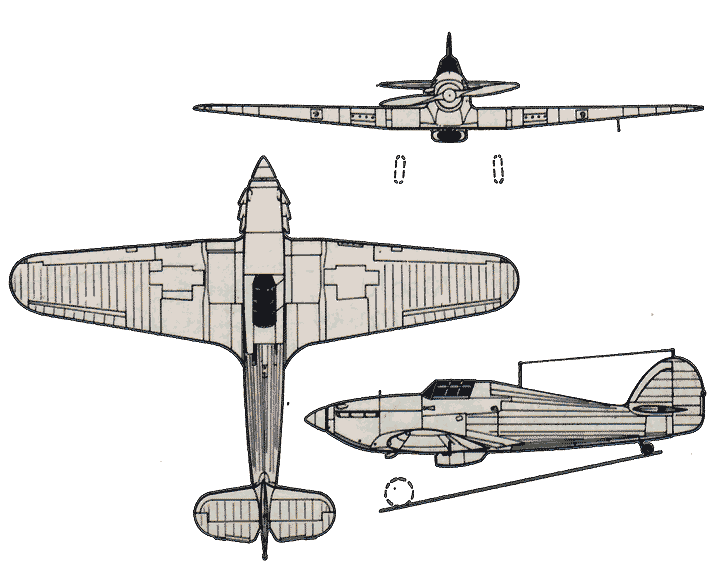


Hawker Hurricane/Typhoon
 A Hurricane Fighter of 61ST Aerial Group, River Bend Civil Defense. |
Main User: Royal British Conglomerate (still called Great Britain)



Hawker Hurricane/Typhoon
 A Hurricane Fighter of 61ST Aerial Group, River Bend Civil Defense. |
| Fuselage- Engine Compartment- Cockpit Canopy- Wings (2)- | 15Ø 19Ø 1ØØ 1 | Tailerons (2) & Rudder- Props (3)- Landing Struts (3)- | 9Ø each 5Ø each 5Ø each |
Speed and Statistical Data: Weapons Systems: Features:Maximum speed: 34Ø mph (54 7 km/h)
Cruising speed: 3Ø7 mph (494 km/h)
Range In The Air: 1,ØØØ miles (1,48Ø km)
Service Ceiling: 4Ø,ØØØ ft. (12,192 m)
Climb Rate: 2ØØ ft/min
Takeoff Length: 15Ø ft unassisted.
Landing Length: 5Ø ft unassisted.
Height: 8 ft. 9 in. (2.66 m)
Wingspan: 4Ø ft. Ø in. (12.19 m)
Length: 32 ft. 3 in. (9.82 m)
Weight: 7,127 Ib.Operational Weight: 8,4 7Ø lb. (3,841 kg)
Fuel capacity internal: About 2,ØØØ lbs.
Fuel capacity external: 5Ø gallons.
Cargo: Pilot’s supplies only.
Power System: One Rolls-Royce Merlin MVI Hydro-Cell Radial Engine;79 kw) at 21,ØØØ ft. (6,4ØØ m).
Flight Systems:
Primary: Standard Grav Pods.
Secondary: Aero-Foil Effect.
Cost and Availability: 15,ØØØ€ each; Routinely available.
Black Market Cost and Availability: 5,ØØØ to 5Ø,ØØØ€ each; Rarish.1. Eight .5Ø caliber machine guns: The workhorse weapon of the entire Warbird series.
Purpose: Anti-Personnel/Armor
Damage: Lead (Ball) shot: 7D6 Per round; Depleted Uranium rounds: 1D6×1Ø MD per round; Burst fire only.
Rate of Fire: Burst fire only; fires i fire round burst per pilots attacks per melee. .5Ø’s used on the Warbird series were specially modified at the factory to be burst fire only.
Range: 6ØØ feet
Payload: 5Ø,ØØØ rounds are normally carried- That’s 1Ø,ØØØ bursts.
Weight: 5Ø lbs
Cost and Availability: 5,ØØØ credits; Occasionally available. Highly sought after, and made by a wide number of black marketers
Ammo Cost and Availability: Ball rounds: 8ØØ to 1,ØØØ credits for a box of 5Ø; Routinely available. DU rounds: Up to 1ØØ thousand credits for a box of 5Ø; Rare. Highly sought after.2. Wing Mounted Weapons Systems: The plane can carry up to 3 pods. 7 Rocket Launcher: 24 2-inch rocket tubes in 12 rows of 4 each. Each rocket tube has 4 rockets.
Purpose: Heavy Assault
MD: Each rocket does 2D6 MD
Rate of Fire: Volleys of 6 or 12 times pilots attacks per melee.
Range: 12,ØØØ feet
Payload: 96 per pod. Up to 6 pods can be carried.
Purpose: Offensive/Anti-Ship
MD: 4D6×1Ø per torpedo
Blast Radius: 4Ø feet
Maximum Range: 8Ø miles
Minimum Range: 5 miles
Rate of Fire: 1 torpedo per pilots attacks per melee.
Payload: Each pod holds 3 Mk-82’s.7 pod, used to drop highly sensitive and extensive messages. A nose-mounted device using GPS or laser detection guides the pod to within ⅛st of an inch of the intended target.
Reduce melee attacks/actions, and combat bonuses by half. Also, a cloud of smoke approximately 25² feet wide and high by about 1 half-mile long. Duration: 1D4 melee rounds. Rate of Fire: Once per melee. Payload: 6 chaff/flares. |
 Schematical view of the Hurricane Fighter. |


